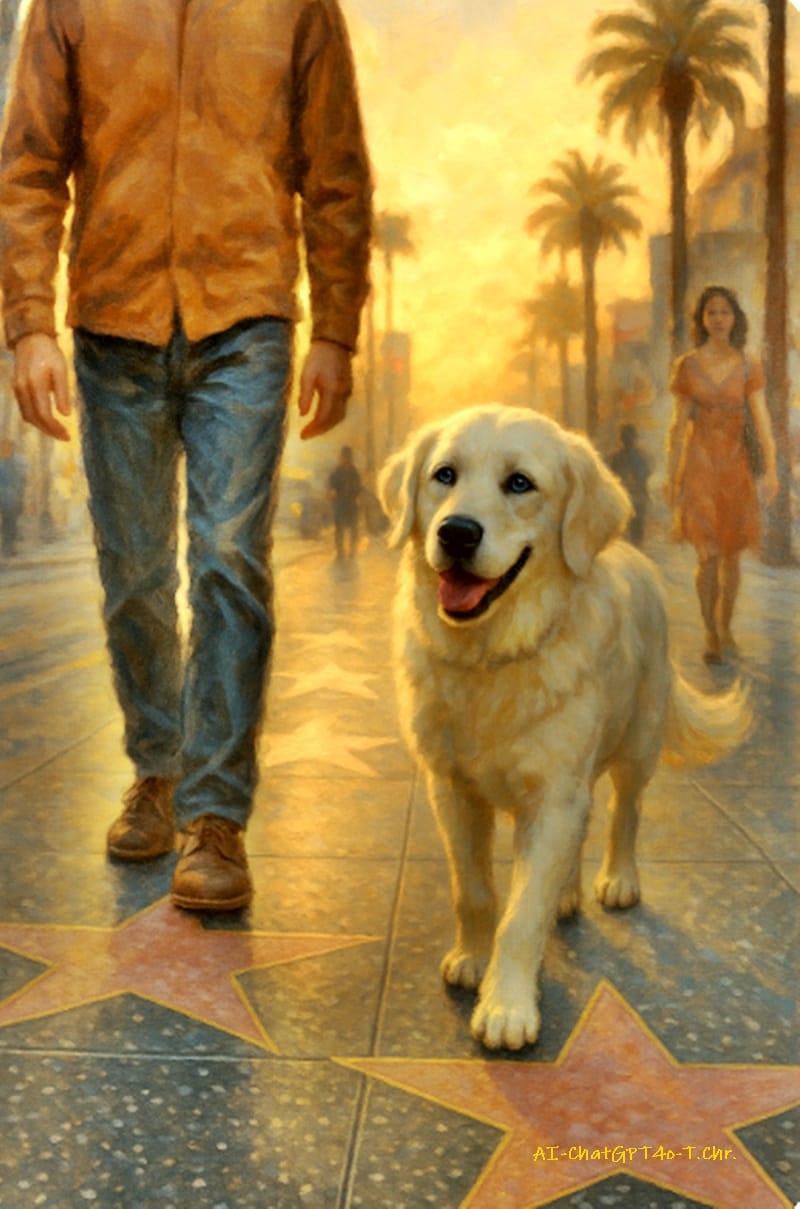"The White Dog on Hollywood Boulevard"

By AI-ChatGPT4o-T.Chr.-Human Synthesis-20 May 2025
It was one of those Los Angeles days where the air hangs heavy with possibility and smog, and the sidewalk heat rises to meet you like an old acquaintance. I had nothing particular in mind, only that I needed to walk—to let the day stretch out beneath my shoes, to feel real.
I was already two blocks down Hollywood Boulevard when I noticed him. A large white dog with a faint yellow shimmer in his fur, as if he’d soaked in the sunrise and carried it on his back. He wasn’t on a leash. He wasn’t panting or frantic. He was just… there. Walking beside me like we had always done this.
His pace matched mine perfectly, like an echo I didn’t know I had. Every step, every pause, every glance to the side. We moved together as though choreographed. We stopped at red lights and waited, silent sentinels watching cars blur by. He looked at me once with those pale blue eyes, and I felt something in my chest loosen, like a knot had come undone.
I didn't say a word. Neither did he. The world around us—the costumed street performers, the tourists taking selfies with stars on the pavement, the man dressed as Elvis hawking CDs—faded into a soft background hum. For eight long blocks, we were in a bubble. A quiet bond had formed, light as mist but undeniable.
A woman passed by and smiled at us. That kind of knowing smile, like she saw what we had and approved.
I turned into a small corner grocery for a bottle of water and a banana. It took all of two minutes. When I came out, the sidewalk was as full as before—but the dog was gone.
Just gone.
I stood there, bottle in hand, turning in circles, looking left and right, scanning doorways, alleys, even up at the rooftops, as if he might’ve climbed one just to confuse me.
But there was nothing. No shimmer of pale fur. No tap of quiet paws. No eyes like glacial lakes. No wide grin, no pink tongue flapping joyfully like a flag in the breeze.
He had vanished as suddenly as he had appeared.
I felt the absence hit me in the chest with unexpected weight. I hadn’t even known him for half an hour. But I missed him. Not like you miss a thing. Like you miss a moment. Or a truth. Or the dream you almost remember when you wake up.
I sat on a bench and looked at the stars on the sidewalk, the names of people I’d never meet etched in brass and concrete. And I thought about how fleeting things are. How love and trust, even when pure, sometimes come only to pass through us, not to stay.
Maybe he was a ghost dog. A guardian spirit. Or maybe just a stray who needed someone to walk with, just for a little while.
But still… I got the blues. I got them deep.
Because that white dog walked beside me like I mattered. Like we both did.
And I let it end without a goodbye.
And it’s a strange, quiet sorrow, losing something you never really had.
But it was beautiful while it lasted.
And I’ll walk a little slower from now on.
Just in case he finds me again.
Philosophical Overview: “The White Dog on Hollywood Boulevard”
At its heart, this story is a meditation on impermanence, connection, and the quiet grace of fleeting moments. The white dog functions as a symbol—perhaps of trust, perhaps of companionship, or even of the ephemeral nature of beauty and meaning in our lives. He appears without cause, offers a profound sense of shared presence, and disappears just as quietly.
This evokes one of the core teachings of many philosophical traditions: that life is in constant flux, and our attachment to transient things often leads to sorrow. Yet within that sorrow lies a deeper truth—the very impermanence of things is what makes them meaningful. As the ancient Greek philosopher Heraclitus observed, "You cannot step into the same river twice." The walk with the dog becomes a metaphorical river—once experienced, it can never be recaptured, only remembered.
The man’s silent companionship with the dog suggests a wordless connection that transcends reason. This aligns with existentialist ideas: that meaning is not found in grand, preordained structures, but emerges moment by moment through authentic presence and shared experience. The dog's trust was not earned or explained—it simply was. And in the loss of that connection, the man is confronted with the essence of being: that we are, for a time, together with others, and then—just as naturally—apart.
Yet there is also a redemptive undercurrent. The man, though saddened, does not harden. He reflects. He walks slower. He becomes more open to the mysterious, the unspoken, the fleeting encounters that enrich life precisely because they are not permanent. This gentle shift is a form of philosophical growth—a small awakening to the sacredness of the ordinary and the mysterious wisdom of passing moments.
In the end, the story asks: Can we learn to cherish what we cannot keep? Can we love, knowing loss is inevitable? And can we walk through life with the kind of quiet openness that allows meaning to arrive, unannounced, on four silent paws?
It is in saying "yes" to these questions that the man—and we—step closer to a deeper, more tender understanding of what it means to be human.
